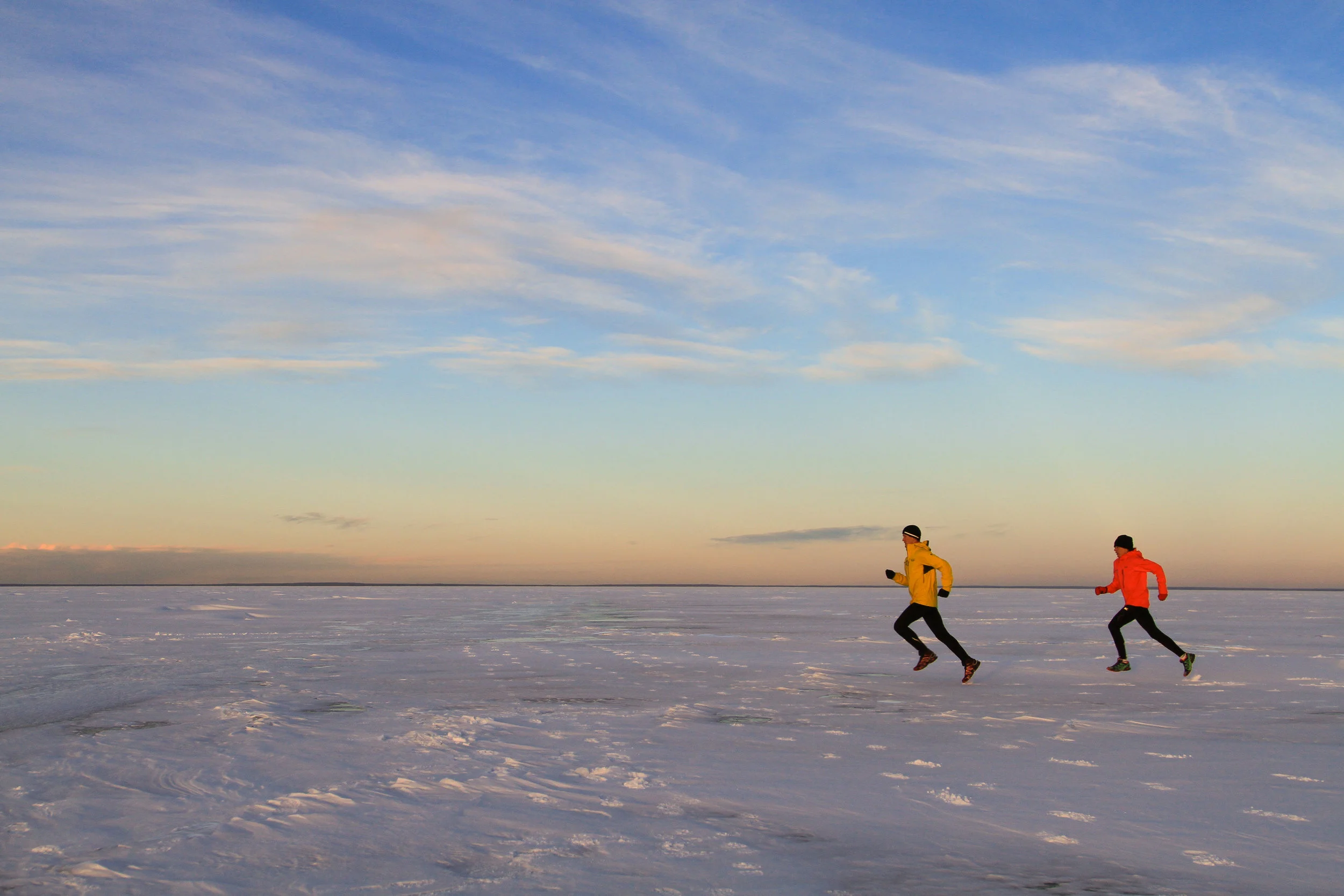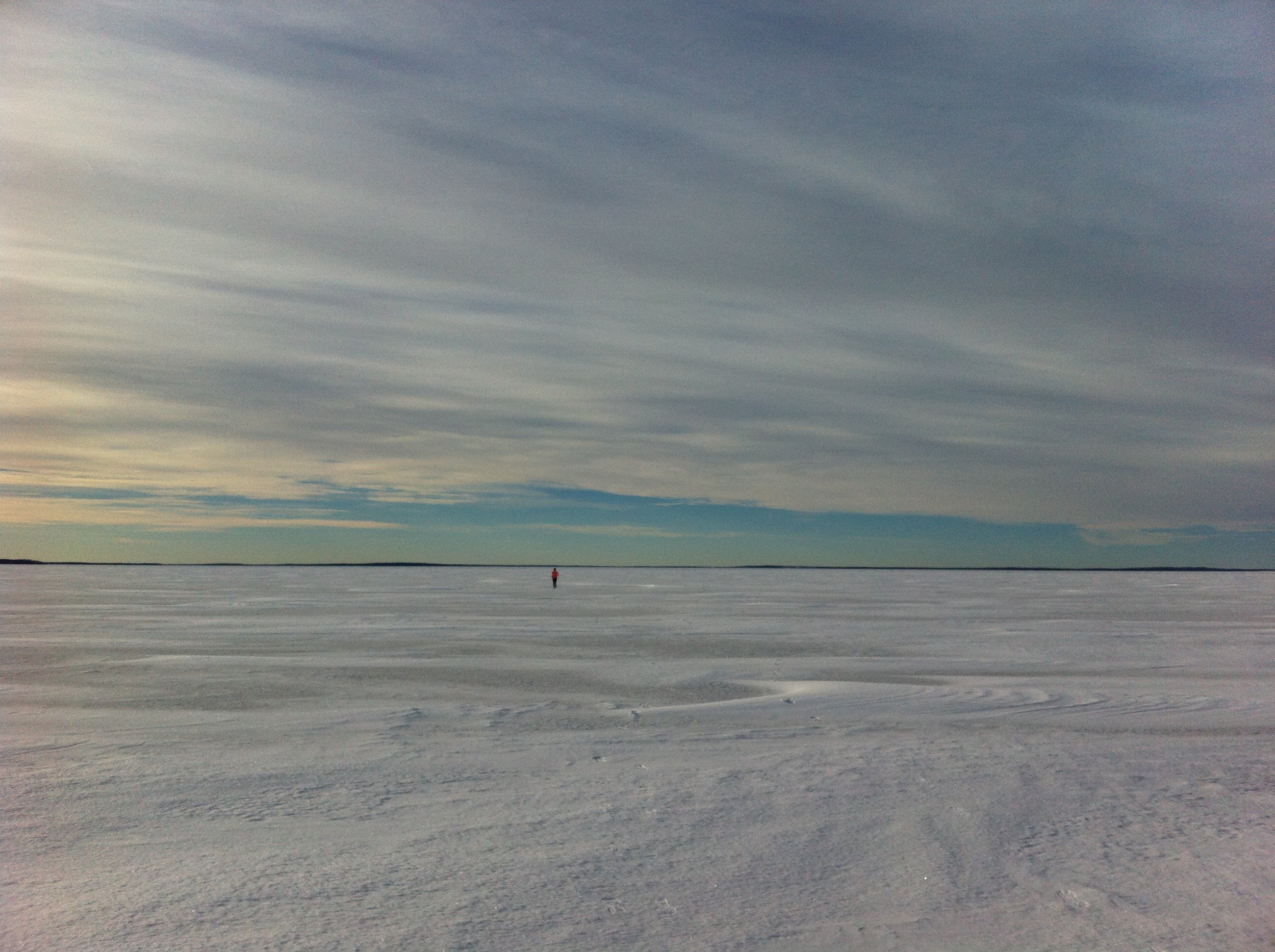By: Matt Setlack
Living in a small town in northern Alberta, Canada has taught me to be creative with training. This morning, Sunday 15 January 2017, I decided to make an attempt to run across Cold Lake. This is not a small lake by any means; it about 25km across! In order to appreciate the size of this lake, you really need to cross it under your own power; then you will understand. This article will briefly describe the journey.
Matt and Emily during a dry run on Cold Lake to check the ice conditions
The narrow black strip of land is 20km away; that's where we are heading. Try to run in a straight line.
Conditions
Before I attempted this run, I talked to as many locals as possible about the ice conditions including two Griffon search and rescue pilots, a fighter pilot, a fish and wildlife officer and I checked the ice conditions online. I made sure a told numerous responsible people exactly where I was going and what time I expected to be back. I was even lucky enough to have my friend, Scott a Ski Patroller on speed dial and my friend, Josh up in the air in a light airplane checking up on me. I believe that in an emergency situation, he could have landed on the ice, if required. However, an ounce of prevention is worth a pound of cure - not getting into a bad situation in the first place is the best thing to do. There is potential for this to be a very dangerous journey and it it definitely not something to take lightly.
Typical ice conditions. Average ice thickness was around 12 inches.
Recon: In preparation for this epic run, I XC skied with Josh and Scott out onto the ice for 28km on Thursday 12 January 2017. I also ran 14km on the ice with Dominik and Emily on Saturday 14 January 2017.
Matt running on Cold Lake during a dry run.
I left the Cold Lake Marina at approximately 9:16 am after the sun had risen. The temperature was around 0C and the wind was about 15kph from the west. These are unseasonably warm temperatures since a few days ago I ran to work in -43C. Conditions were nearly ideal for a crossing attempt.
What I Brought With Me
What I wore (bottom to top): Running Room (RR) mono skin thin socks, RR lightweight summer spans, black RR wool blend long sleeve top, orange buff, RonHill tuque, simple thin fleece mitts, polarized glacier glasses (so I could see through the ice without the glare and check ice thickness). I have put a lot of effort and thought into every piece of running gear I wear. All of these items worked extremely well and I fully endorse and highly recommend them.
What I brought in my backpack: A complete set of dry clothing (in a dry bag) in the event that I broke through the ice including spare RR spans, spare socks, spare long sleeve, wind shell, lightweight down parka, spare tuque, spare face mask and spare mitts. Although this may have been a little excessive, I would rather have it and not need it than not have it and need it. I also brought 1.5L of warm water, many energy bars, several chocolate bars, mini eggs, vapour barrier socks, fire starting kit, compass, map, mobile phone in a ziplock bag, sharpened tent stakes tied together with a string and draped over my neck (in the event that I was to break through the ice), whistle, headlamp, peanuts and 2 x $10 cash.
Challenges/Hazards
Breaking Through the Ice - I was lucky that the temperature was warm today unlike the more typical -30C that we experienced during our dry ski run. If you break through the ice in these cold conditions, it is very likely that you will not survive. There is no fuel to burn on the ice to make a fire and warm up and you are literally 10km from shore in the middle of the lake (1-2 hours).
Getting Lost in a Whiteout - As odd as it may sound, it is very challenging to walk in a straight line when you're in the middle of a lake with few visual references. If you got lost in a whiteout, you could wander for days and eventually suffer from hypothermia. Keep in mind that on the lake there are no building materials to make a shelter (not enough snow)
My Recommendations
Run with a friend. Let someone responsible know where you're going and what time you'll be back. Don't attempt a 45-50km run if you don't train for running on a regular basis. This is a substantial distance under potentially adverse conditions; it is not a walk in the park. You must respect the distance and be prepared to turn around in the conditions get bad. Always follow your trail back exactly the way you came; don't deviate at all. Don't rely on someone else to get you out of a bad situation; be prepared to get yourself out of it.
Matt and Emily during a dry run to check the ice conditions on Cold Lake.
Cold Lake Crossing Route (Attempt #1). Total distance of 43km.
Unfortunately, I ended up running out about 20km and had to turn around due to a open water lead that I was unable to cross as the ice was much too thin to support my weight. I was approximately 3-4km from the NE shore. Due to the limited daylight, it was important that I turned around to ensure I returned before nightfall.
According to Strava, the total distance ended up being 43.1km with a moving time of 4:29:16. Overall, it was a very enjoyable long run. I would recommend waiting until mid-February 2017 (depending on conditions) to try this run again.
An open water lead with ice that was much too thin to cross. The lead stretched for miles as far as the eye could see.












